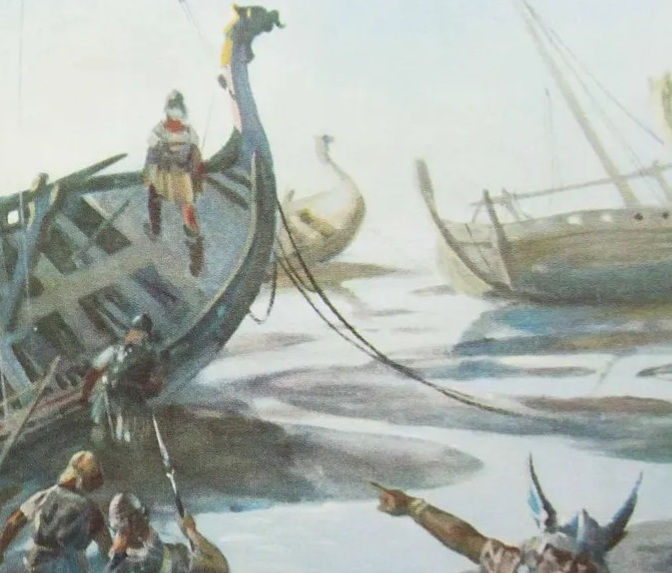In search of the De Veres - St Nicholas Church at Castle Hedingham
- Michael Smith, printmaker, Mythical Britain
- Jul 22, 2018
- 4 min read
Updated: Oct 8

The sun, the day, the world was in alignment; out of the garage comes Gringolet, ready to take me to the glory of England which is north-west Essex. I have been to Castle Hedingham on many occasions but this time I wanted to visit its astonishing church, the church of St Nicholas. I recommend it!
On an old Francis Barnett, you have to take the world as it comes: slowly. A maximum speed of 58mph and an average speed of somewhat less means you have to let the day take all control. This is a world where nothing comes quickly, no bad thing really when your choice of ride is through some of the richest farmland in Britain. On a summer's day, the fields are golden, the road rolls on and every bend brings bright new vistas...

One such is Castle Hedingham, visible for miles as you take the old road from Radwinter, via Steeple Bumpstead and Wixoe. The great keep of the de Veres is an astonishing sight as it stands visible over all which it surveys, not unlike Loches in the Loire. This seat of the Earls of Oxford is impressive enough but castles are one thing and churches another...
At St Nicholas, in the heart of the village, we see a more intimate side to mediaeval life than we find in the great keep. Parking Gringolet by an old gate in the ancient lane of Church Ponds, I speak briefly to an elderly inhabitant about my journey, before walking towards the church.
Norman, Mediaeval and Tudor Work
St Nicholas is a curious blend of Norman, late mediaeval and Tudor, with a little bit of Victorian thrown in (but not too much to desecrate the place with its over-mechanised, far-too-literal interpretation of mediaeval craft).
The brick Tudor tower is truly impressive and adds a rich splash of colour to the scene. Yet it is the Norman work which is of particular interest. Here we find wooden doors which would have known the de Vere family members who built the great Norman keep.
One of these doors once carried the skin of a man (allegedly), although research of similar doors at Hadstock revealed the skin actually to be from a pig, probably added to water/ wind-proof the doors in distant times.
A church cross, which was found in a cellar in the village, now once more graces the exterior of the church. This astonishing edifice may indeed be partially Saxon; showing that here was a place which lived long before the Normans came.
Norman pillars and wheel window
The interior is rich in Norman work however. By the door is a stunning Romanesque stoup, with the type of design we might see at Kilpeck in Herefordshire; such style cues do not occur elsewhere in this church which might suggest an earlier building.. We also see alternating round and octagonal piers holding the arcades, Pevsner dates the work on the capitals as suggesting a build of around 1180.
In pride of place, however, is the chancel at the East end with its magnificent wheel window. Such survivals are rare. I have seen such a window at Barfreston near Canterbury; this example, though restored, is crisp in form, with intricate carved heads to each spoke.
During the Victorian restoration, apparently, it was discovered that one of the spokes was made of wood. We might imagine some mason's disaster in those distant Norman days resulting in a quick fix for a repair which never happened until 700 years later!
Screen and stalls - exquisite detail and misericords
If the Norman work of the early de Veres is fascinating, so too is the work of later carpenters and joiners. The misericords in the chancel stalls are particularly fine. One features a fox carrying off a priest; another shows a man's face between two leopards.
The Screen is also a magnificent achievement. Though not as glorious as some, it is finely carved and assembled with delightful details near the entrance of a lord and his lady; possibly the de Veres themselves. The Screen dates from the 14th Century.
Hammer beam roof
One of the crowning glories of the church is its magnificent double hammer beam roof in the nave. Sadly, the wood is so dark that it is difficult to see the workmanship close up (my photographs of some of the details have been enhanced to try to show some of the workmanship).
This work is of the later middle ages but, as Pevsner says, it is "a crowning motif (and) is worthy of the Norman columns". An interesting feature, towards the chancel, is how the final columns merge Norman design with that of a later period.
Near disaster!
What a glorious and rewarding day. Well, almost. To travel the old roads of England on an old motorcycle brings pleasures and experiences often forgotten in today's speeding world.
On my return journey, travelling at around 55mph, I was suddenly compelled to make an emergency stop with a car heading towards me in the opposite direction.
For reasons unknown, save indeed to Gringolet, the rear brake completely failed (the front ones on old British motorcycles being usually next to useless). I am unclear how I managed to stop in time by using only the engine as a brake, and then my feet. It was a little alarming.
Gringolet had had a minor fit. But there's always another day - after a few repairs.
About the author, Michael Smith

I am a British translator and illustrator of medieval literature. I am also an accomplished printmaker, with work in private collections worldwide.
My books, including a translation of Sir Gawain and the Green Knight and the Alliterative Morte Arthure, are available through all the usual outlets. My translation of The Romance of William and the Werewolf was published in 2024. All my books feature my own linocut prints as their illustrations.
To find out more about me, please click here
For more details of my books and how to purchase signed copies, click here.
Photo Gallery - please view the slide show to see just a fraction of the glories on display at St Nicholas Church, Castle Hedingham, Essex.
#KingArthur #SirGawainandtheGreenKnight #CastleHedingham #StNicholasChurch #Gringolet #FrancisBarnettFalcon81 #FrancisBarnett #NikolausPevsner #DeVere #Essex #SteepleBumpstead #Wixoe #Radwinter #Loches #Loire #ChurchPonds #Hadstock #Norman #Saxon #Hammerbeamroof #AlliterativeMorteArthure #EarlsofOxford #stoup #Kilpeck #Herefordshire #Barfreston #Canterbury #Kent #Wheelwindow #misericord #Church #HistoricChurches #HistoricChurch
























Comments